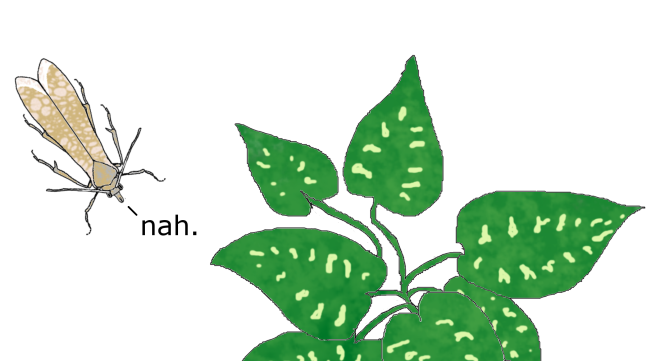 The term ‘stand your ground’ has particular significance for the plant kingdom. When faced with hardship (eg: drought, flooding, extreme heat, freezing temperatures, or herbivory) plants do not have the option of retreating. Instead plants stick it out, finding more subtle ways of fighting back.
The term ‘stand your ground’ has particular significance for the plant kingdom. When faced with hardship (eg: drought, flooding, extreme heat, freezing temperatures, or herbivory) plants do not have the option of retreating. Instead plants stick it out, finding more subtle ways of fighting back.
A new open access study from a team at the University of Missouri-Columbia and published in the journal Oecologia has uncovered a fascinating new discovery: plants are able to detect the vibrations made by their enemies, and respond by producing higher levels of chemical defences within their leaves. These chemical responses of the plant can reduce herbivory in many ways including: making plant tissues unpalatable, or even negatively impacting growth of the herbivore.
In this study, the team used two familiar species. The first is rockcress (Arabidopsis thaliana) a plant in the mustard family familiar to most geneticists. The second was the larval form of the cabbage butterfly (Pieris rapae) – a species often too familiar to veggie gardeners, and producers of brassica crops.
The researchers placed a caterpillar onto a leaf of the rockcress. By measuring the miniscule movement of the plant leaf as a caterpillar fed, the team was able to capture the vibrations caused by the chewing mandibles. This isolated sound was then used within further experiments to test the impact of sound in triggering host-plant defence.
The recordings were then played back to two naïve plants, through the use of a tiny motor called an actuator. Plants that received vibrations based on caterpillar mandibles were known as ‘chewing treatment‘, while two other naïve plants were subjected to a still actuator control ‘silent treatment‘. Larvae were added to the plants and allowed to feed until 30% of the leaf had been consumed. Then, the researchers sampled different types leaves: the leaf which had been directly vibrated + chewed, a leaf within the rosette of similar size and age, and a younger leaf in the rosette centre.
The team then analysed the concentration of a class of chemicals within the leaf that is known to deter herbivores: glucosinolates (think of the pungent, peppery taste of raw cabbage). The team found that leaves subjected to the ‘chewing treatment’ had roughly 20% higher concentrations of glucosinoates than leaves sampled from the ‘silent treatment’. This was found both locally (leaves directly chewed), and systematically (un-chewed, but systemically vibrated rosette leaves of the same age).
The team then looked to test whether plants could differentiate ‘bad vibrations’ (caused by herbivory of the caterpillar) against ‘benign vibrations’ caused by wind, or the song of a leaf-hopper. This time the researchers looked at a different group of chemicals: polyphenol anthocyanins – the same chemicals that give a blueberry it’s rich purple-blue colour. These chemicals are also secondary defence chemicals used to reduce herbivore vigour, and render leaves less palatable by herbivores.
Using the same experimental design the researchers found that plants exposed to vibrations simulating caterpillar feeding resulted in significantly higher levels of polyphenol anthocyanins than plants subjected to benign vibration treatments. This effect was not observed unless plants were subsequently exposed to actual feeding. This suggests vibrations had a priming effect, rather than directly affecting the level of a plants response.
This study is a perfect demonstration of just how successful plants have become at defending themselves against their enemies. It is even possible that plants might ‘eavesdrop’ on the vibrations of a neighbouring plant, similar to the way plants can respond to the chemical cues of their neighbours/competitors. We can now add ‘sensing vibration’ to the growing toolbox that plants use to defend themselves against their enemies. Please stay tuned for more about the wonderful world of plant defence. It only gets stranger.
Reference:
Appel, H. M., & Cocroft, R. B. (2014). Plants respond to leaf vibrations caused by insect herbivore chewing. Oecologia, 175(4), 1257–66. doi:10.1007/s00442-014-2995-6


